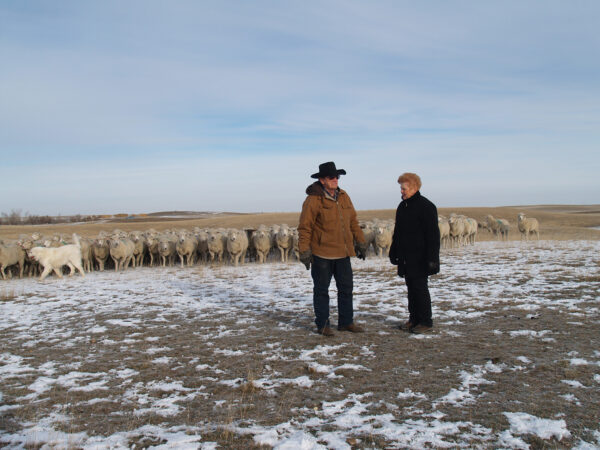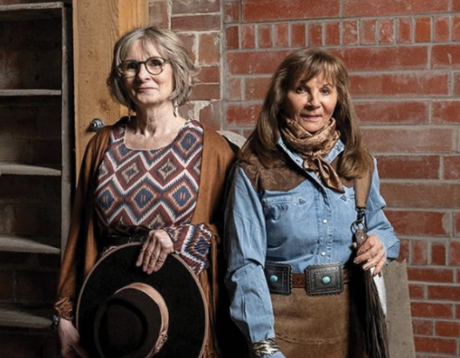Shepherds, Dogs & Lambing
Photos and Story by Terri Mason
When it comes to multi-award-winning stock dog trainer Dale Montgomery and his wife, Dawn, the sheep business is a 24/7 job, and one of the busiest times is, of course, lambing.
“Our ewes give birth usually mid-April into May. Where they give birth depends on the weather; most lamb in our large shed. We also have the lambing field, which is fine if the ewe gives birth to one lamb, but the main problem with sheep is when they’re lambing twins or triplets, the firstborn lamb can often wander into the flock and get separated from their mothers and end up as orphans. We watch very carefully. We’ll bring in the ewe and her lambs and lock them up in a small pen for a day or two until they’ve bonded,” said Dale.
“If you have lots of space and your sheep are really spread out that’s not as much of a problem. But when you have them in a more confined area, then they’re more likely to get mixed up,” said Dawn. “But it’s the multiple lamb births you want because it’s more profitable.”

Spring 2022 lambing pen, used for twins so they can mother up well and fit into the flock.
But, like everything in life, there’s good and bad — and sometimes, confusion.
Cattle producers are well aware of the strain of pulling calves, and with sheep, there’s an added wrinkle.
“If she’s having trouble, you can just lay her down and pull the lamb right there, but it’s rare that we have to pull a lamb,” said Dale. “Sometimes you’ll get a big single lamb. The biggest struggle we have is when they’re having triplets, and the lambs are all mixed up in the womb. You’ll get a leg of one and a leg of another, so you have to be very careful.”
But once they’re out, just like calves and foals, the nectar of life for lambs is colostrum.
“You’ve got to make sure the lamb gets colostrum very soon, within a few hours. If they don’t, they’ll die — usually within a week,” said Dale.

Ewe with her twins on the ground, and another lamb behind her stealing a snack
Once the twins/triplet lambs have been assured colostrum, are in good condition, and have bonded with their mothers, then they are turned into the separate flock that has already lambed. There, the lambs and ewes are still in fairly close quarters, so no one gets separated or orphaned.
To turn the new mothers into the already lambed flock, the Montgomery’s simply open gates, and use theborder collies sparingly. “Mothers can be quite protective of their newborns,” understated Dawn.
CUSTOM GRAZING
Historically, Montgomery’s pastures were always in good shape, and soon, they were asked if the sheep could help with a friend’s noxious weed problem.
“And that’s when we got into custom grazing,” explained Dale.
The first place Montgomery’s custom grazed for weed control was a neighbour’s outfit to reduce the overgrowth of burdock.
“The sheep opened up a lot of areas they didn’t have access to because of overgrowth and bush. They cut the burdock, but they also ate a lot of it. At a certain stage, burdock is very palatable, and they got so they really liked it,” said Dawn.

Washable spray paint is used to mark lambs and ewes for easier pairing
Another benefit of reducing burdock was fewer vet bills. “It opened the areas up where cattle were nervous to eat. He used to cull a lot of cows every year because of bad eyes. The year that we started there ended the bad eyes caused by the burrs. It didn’t get rid of the burdock entirely; wildlife spreads it too, but it made a big difference to him for a few years,” she continued.
Then the Scourge of the West, Leafy Spurge, became a menace — and Montgomery’s custom grazed to reduce that noxious weed too.
“Custom grazing controlled the Leafy Spurge, but it didn’t wipe it out. You have to keep at it — same as burdock,” she said.
Montgomery’s would literally move onto a pasture with 1,000 head of sheep (ewes and lambs) of theirs and other producers, their mobile camp, four good border collie dogs, a savvy horse, and a few guard dogs who literally live with the flock 24/7. [They use Pyrenees/Maremma-cross.]
“You’re out there herding the sheep from horseback (or quad) all day, every day from daylight to dark, whether it’s raining or 105 degrees in the shade,” Dale explained.

“We’ve been raising sheep since the ‘80s. I got a handful of sheep when I got working [border collie] dogs. Then I got a few more, and a few more, and then we had 200,” said Dale.
At night, the sheep are penned in a temporary enclosure made with an electric fence. The next day, the shepherds situate the sheep in a heavily affected area and keep them together to eat the noxious weeds. “There is the saying that “nothing survives passing through a sheep,” so seeds don’t germinate.”
With the hundreds of thousands of acres that the Montgomery flock has grazed, neither Burdock nor Leafy Spurge has ever been brought home to the Montgomery Ranch.
“For all the years we custom grazed, we never brought burdock or leafy spurge seeds home,” said Dale. “These days, we have a love for our sheep and our dogs, but with the price of hay, we’ve decided to retire. We’ll miss them. Sad but true, but that’s what worked for us.”
















